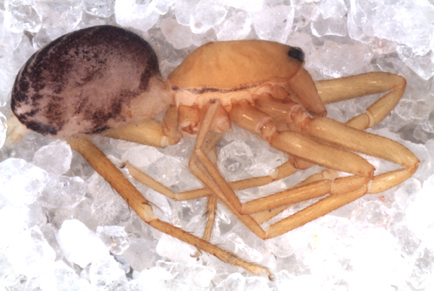Abstract
A faunistic survey in the Maule region in central-southern Chile resulted in the discovery and description of a new species of the spider genus Osornolobus: O. violetaparra n. sp., based on males collected using pitfall traps in the province of Talca. This is the northernmost record of the genus in Chile, previously known from Ñuble to Magallanes.
References
- Becerra, P.I. & Simonetti, J.A. (2020) Native and exotic plant species diversity in forest fragments and forestry plantations of a coastal landscape of central Chile. Bosque, 41 (2), 125–136. https://doi.org/10.4067/S0717-92002020000200125
- Chousou-Polydouri, N., Carmichael, A., Szűts, T., Saucedo, A., Gillespie, R., Griswold, C. & Wood, H.M. (2019) Giant Goblins above the waves at the southern end of the world: The biogeography of the spider family Orsolobidae (Araneae, Dysderoidea). Journal of Biogeography, 46 (2), 332–342. https://doi.org/10.1111/jbi.13487
- De La Vega, X., Grez, A.A. & Simonetti, J.A. (2012) Is top-down control by predators driving insect abundance and herbivory rates in fragmented forests? Austral Ecology, 37, 836–844. https://doi.org/10.1111/j.1442-9993.2011.02345.x
- Echeverría, C., Coomes, D., Salas, J., Rey-Benayas, J.M., Lara, A. & Newtone, A. (2006) Rapid deforestation and fragmentation of Chilean Temperate Forests. Biological Conservation, 130, 481–494. https://doi.org/10.1016/j.biocon.2006.01.017
- Grismado, C.J. (2008) A taxonomic revision of the spider genus Ariadna Audouin, 1826 in Argentina and Chile, with the description of five new species (Arachnida, Araneae, Segestriidae). Zoosystema, 30, 333–360.
- Forster, R.R. & Platnick, N.I. (1985) A review of the austral spider family Orsolobidae (Arachnida, Araneae), with notes on the superfamily Dysderoidea. Bulletin of the American Museum of Natural History, 181, 1–230.
- Izquierdo, M.A. & Labarque, F.M. (2010) Description of the female of Orsolobus pucara Forster & Platnick 1985, with comments on the functional morphology of the female genitalia in Dysderoidea (Araneae: Dysderoidea: Orsolobidae). Journal of Arachnology, 38, 511–520. https://doi.org/10.1636/A09-071.1
- Lipke, E., Ramírez, M.J. & Michalik, P. (2014) Ultrastructure of spermatozoa of Orsolobidae (Haplogynae, Araneae) with implications on the evolution of sperm transfer forms in Dysderoidea. Journal of Morphology, 275 (11), 1238–1257. https://doi.org/10.1002/jmor.20298
- Miranda, A., Altamirano, A., Cayuela, L., Lara, A. & González, M. (2017) Native forest loss in the Chilean biodiversity hotspot: revealing the evidence. Regional Environmental Change, 17 (1), 285–297. https://doi.org/10.1007/s10113-016-1010-7
- Myers, N., Mittermeir, R.A., Mittermeir, C.G., Da Fonseca, G.A.B. & Kent, J. (2000) Biodiversity hotspots for conservation priorities. Nature, 403, 853–858. https://doi.org/10.1038/35002501
- Ott, R., Platnick, N.I., Berniker, L. & Bonaldo, A.B. (2013) Basibulbus, a hard-bodied, haplogyne spider genus from Chile (Araneae, Dysderoidea). American Museum Novitates, 3775, 1–20. https://doi.org/10.1206/3775.2
- San Martín Acevedo, J. (Ed.) (2022) Taxonomía, Distribución, Ecología y Dinámica de Los Bosques. In: San Martín Acevedo, J. (Ed.), Los bosques relictos de Ruil: ecología, biodiversidad, conservación y restauración. CMPC & INFOR, El Sur Impresores Ltda, Biobío, pp. 70–134.
- SIMEF [Sistema de Monitoreo de Ecosistemas Forestales Nativos de Chile] (2022) Available from: https://simef.minagri.gob.cl/ (accessed 30 April 2023)
- Smith-Ramírez, C., Grez, A., Galleguillos, M., Cerda, C., Ocampo-Melgar, A., Miranda, M.D., Muñoz, A.A., Rendón-Funes, A., Díaz, I., Cifuentes, C., Alaniz, A., Seguel, O., Ovalle, J., Montenegro, G., Saldes-Cortés, A., Martínez-Harms, M.J., Armesto, J.J. & Vita, A. (2023) Ecosystem services of Chilean sclerophyllous forests and shrublands on the verge of collapse: A review. Journal of Arid Environments, 211, 104927. https://doi.org/10.1016/j.jaridenv.2022.104927
- Vergara-Asenjo, G., Alfaro, F.M. & Pizarro-Araya, J. (2023) Linnean and Wallacean shortfalls in the knowledge of arthropod species in Chile: Challenges and implications for regional conservation. Biological Conservation, 281, 110027. https://doi.org/10.1016/j.biocon.2023.110027
- White, D.A., Silberstein, R.P., Balocchi-Contreras, F., Quiroga, J.J. & de Arellano, P.R. (2020) Contribution of Advanced Regeneration of Pinus radiata D. Don. to Transpiration by a Fragment of Native Forest in Central Chile Is out of Proportion with the Contribution to Sapwood Area. Forests, 11 (2), 187. https://doi.org/10.3390/f11020187
- World Spider Catalog (2023) World Spider Catalog. Version 23.5. Natural History Museum Bern, Bern. Available from: http://wsc.nmbe.ch (accessed 30 April 2023) https://doi.org/10.24436/2


